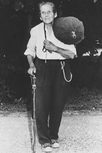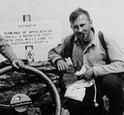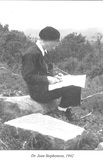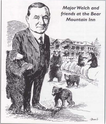2012 Class

Emma Rowena “Grandma” Gatewood She spent most of her life on farms along the Ohio River. One of fifteen siblings, she married and raised eleven children. Surprisingly, she had never hiked much. Then, she read an article in the National Geographic magazine about the A.T. In 1954, at age 66, she started hiking the Trail, but didn’t get too far. The next year she made it the whole way, hiking in her legendary Keds sneakers with a laundry sack over her shoulder and a shower curtain to sleep on. She became the first woman to thru-hike the A.T. by herself and in a continuous hike. In 1957, she did it again and later completed a third hike in sections. Over the span of 18 years she hiked more than 14,000 miles. She inspired two distinct movements in long distance hiking, women thru-hikers and the ultra-lite movement.

David A. Richie. Six years after Congress adopted the National Trails System Act, he successfully sought responsibility for the neglected A.T. when he accepted a new job in the National Park Service’s northeast regional office. Eventually, he obtained approval for a separate A.T. Project Office. He was largely responsible for developing the “cooperative management system” used to manage the A.T. today. He saw the potential of the volunteer corps of the ATC, and he knew how to work the bureaucracy without ever appearing to be bureaucratic himself. In 1984, he led the effort to delegate to a private nonprofit organization the day to-day management of the 100,000 acre A.T.

J. Frank Schairer. He was a Yale-trained chemist recognized for an important advance in weaponry during World War II. Meanwhile, he spent most of his adult life volunteering on behalf of the A.T., serving with the Potomac Appalachian Trail Club, the Maine AT Club, and on the ATC Board of Managers. But his favorite trail-related activity was building, blazing and maintaining the actual footpath. Under his supervision, PATC constructed and blazed about 260 miles of the A.T. from 1928 to 1932. Their work contributed to the formation of Shenandoah National Park in 1935. He undertook a similar trailblazing expedition in Maine in 1933 with a PATC group that included Myron Avery, laying out the path through the Hundred Mile Wilderness.

Jean Stephenson. The standards she set for ATC guidebooks and other publications have endured. Her knowledge of the Trail was encyclopedic and her perspectives on its development and nature from the early 1940s seem as fresh today as when they were written. She joined in Myron Avery’s intense 1935 expedition to mostly finish the route through Maine. After the passage of the 1968 National Trails System Act, she aggressively lobbied timber companies and other major landowners in Maine to contribute to a new corridor for the footpath. Ms. Stephenson was in many ways a shadow chairman of ATC during most of the quarter-century Avery was at the helm of PATC, the Maine AT Club as well as ATC itself. After Avery's death, she held ATC together and assumed his role as liaison to federal agencies and counselor to the board.

Major William Adams Welch played a pivotal, pioneering role in the history of public recreation in America. He was the first general manager of the New York–New Jersey Palisades Interstate Park Commission. After earning the rank of major in the Signal Corps during World War I, he returned to restore Palisades Park and work with the legendary Stephen Mather to evaluate possible national park sites in the east. Then, he began routing the first section of A.T. through New York State with the New York–New Jersey Trail Conference. Welch designed a square, die-cut copper marker with the A.T. monogram that endures as the Trail’s most recognized symbol. In 1925, he was named the chairman of the initial meeting to coordinate the planning and development of the A.T., called the “Appalachian Trail Conference”.
